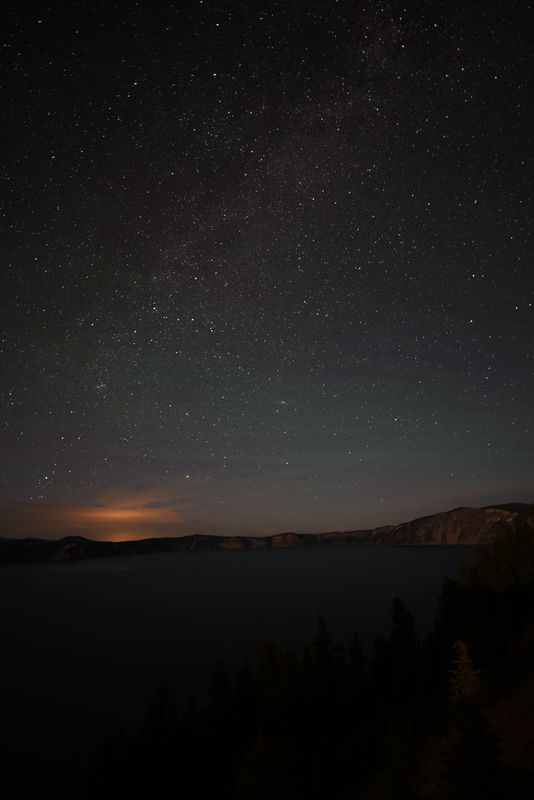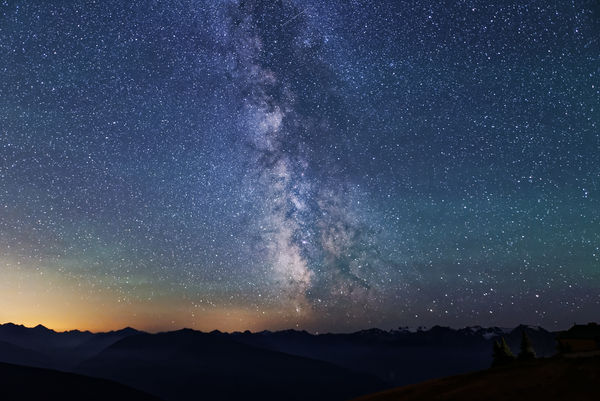Odd color banding in night shots
Aug 10, 2015 23:12:41 #
Ron-Indy
Loc: Indy
I've just begun experimenting with Milky Way shots and noticed that in many of these shots, my Nikon D750 seems to be capturing or creating odd color banding between the lower lighter sky and and the darker upper sky. In post production they become even more noticeable. I shoot RAW & JPG simultaneously and it is visible in both. ISO 5000 at 10 second exposures or ISO 800 at 30 seconds, doesn't seem to matter.
This is the untouched / as shot JPG as taken @ Crater Lake Oregon a few weeks ago:
D750
Nikon 20mm 1.8
ISO-800
f/1.8
30 seconds
auto white balance
My question is:
- What is the cause?
- What can I do to prevent?
- Is it possible to remove / minimize in Photoshop/Lightroom/OpticPro?
OK to modify if anyone would like.
Thank you
This is the untouched / as shot JPG as taken @ Crater Lake Oregon a few weeks ago:
D750
Nikon 20mm 1.8
ISO-800
f/1.8
30 seconds
auto white balance
My question is:
- What is the cause?
- What can I do to prevent?
- Is it possible to remove / minimize in Photoshop/Lightroom/OpticPro?
OK to modify if anyone would like.
Thank you
Aug 10, 2015 23:23:24 #
Not that I'm a knowledgeable astronomer or anything like that but I don't notice any abnormal "banding" .....unless you are talking about the greenish arboreal banding ......if that is the case you have to bitch to a higher power than a camera maker ! :)
Aug 10, 2015 23:29:07 #
Ron-Indy
Loc: Indy
TucsonCoyote wrote:
Not that I'm a knowledgeable astronomer or anything like that but I don't notice any abnormal "banding" .....unless you are talking about the greenish arboreal banding ......if that is the case you have to bitch to a higher power than a camera maker ! :)
So that's a natural phenomenon? Shows what I know! Just to be sure, it's more visible here in what is probably considered a poorly photoshop'd file
Aug 10, 2015 23:35:53 #
Ron-Indy wrote:
So that's a natural phenomenon? Shows what I know! Just to be sure, it's more visible here in what is probably considered a poorly photoshop'd file
Yup! what the naked eye can't see is revealed by your 10-15 second exposure with a good camera ! :)
Fantastic shots BTW ! :thumbup:
Aug 10, 2015 23:46:40 #
Ron-Indy
Loc: Indy
TucsonCoyote wrote:
Yup! what the naked eye can't see is revealed by your 10-15 second exposure with a good camera ! :)
Fantastic shots BTW ! :thumbup:
Fantastic shots BTW ! :thumbup:
Thank you very much! I can sleep peacefully tonight now :)
Aug 11, 2015 04:22:22 #
Aurora Borealis or northern lights is what I meant ...Arboreal has to do with trees ! ....Anyway ! :)
(will teach me to believe auto correct ! ) :roll:
(will teach me to believe auto correct ! ) :roll:
Aug 11, 2015 07:40:53 #
TucsonCoyote wrote:
Not that I'm a knowledgeable astronomer or anything like that but I don't notice any abnormal "banding" .....unless you are talking about the greenish arboreal banding ......if that is the case you have to bitch to a higher power than a camera maker ! :)
If the 750 has no anti aliasing filter it could contribute to banding which first popped up when they took the filter out of the d7100. What I see is nothing like the banding that can show up in a low light image taken with the 7100. Where I find I get it is if I'm shooting a sunset and it has shadows.the shadow part will have severe banding.Have shot the milky way and none present.
By the way if you using PS or Lightroom for processing, drop in into raw converter and use the dehaze found in effects. does a bang up job on night shots
just read up on the d750 and unlike the 7100 it does have the anti aliasing filter.
Aug 11, 2015 08:18:29 #
The camera can sometimes see what the eye can't. Read up on Blue Hour photography. When you take a picture of the sky within an hour before sunrise or after sunset, the sky will look black to the photographer, but deep blue to the camera. I think that's what's happening here. The camera is seeing variations in the lighting in the sky. Either that, or your camera is broken. :D
Aug 11, 2015 09:48:21 #
I don't see any banding or haloing. Could it be possible that there are some light clouds above the horizon? With your shutter open so long it has picked that up. That's what it looks like to me.
Aug 11, 2015 10:11:14 #
Ron-Indy wrote:
I've just begun experimenting with Milky Way shots... (show quote)
Ron,
If what you are referring to is the faint changes of light and color between the horizon and the stat pattern, you are probably seeing atmospheric layering in the Stratosphere. Look at that area at 100% magnification, you will be sable to see the layers of the atmosphere.
It is natural, you are lucky to have captured it, this gives the night sky a 3-D effect.
Look at the stars at 100% and notice the slight blur. If you used a long exposure and a solid tripod you may want to look at a star tracking tripod. This is used for large telescopes to track the Moon, planets, and stars so there is no earth movement during the exposure.
Michael G
Aug 11, 2015 11:36:00 #
Green and magenta appearing in long exposure night sky shots has been commented on before in UHH. Some put it down to peculiarities of the camera when capturing low levels of light. Personally I think it's more than just a coincidence that green and magenta are the main colours of the Aurora Borealis. As Jerry pointed out, the camera will reveal things that the eye can't see during a long exposure.
The other colours that you might see in shots like that are due to
a) atmospheric haze (at night it's predominantly blue, but may include purple/magenta).
b) light pollution (it's colour depends on the source - typically it's yellow and/or orange from street lights).
If you're lucky you might capture a variety of colours that are a natural part of the Milky Way.
If the green and magenta bother you, you could use an HSL tool to target those colours. You could either darken and desaturate them to minimise their presence or you could shift them towards a more typical sky colour like blue.
The other colours that you might see in shots like that are due to
a) atmospheric haze (at night it's predominantly blue, but may include purple/magenta).
b) light pollution (it's colour depends on the source - typically it's yellow and/or orange from street lights).
If you're lucky you might capture a variety of colours that are a natural part of the Milky Way.
If the green and magenta bother you, you could use an HSL tool to target those colours. You could either darken and desaturate them to minimise their presence or you could shift them towards a more typical sky colour like blue.
Aug 11, 2015 22:06:15 #
Aug 11, 2015 23:58:28 #
Ron-Indy
Loc: Indy
Thanks for all the comments - I participate in a few other forums and I have to say the quality and quantity of the responses here are far and away superior. Thank you again.
Hard to quote the variety of responses all in one post but I'll try this way, newest first:
"Could you have captured the 'green flash?'"
Possible but since both the Crater Lake Oregon and Hurricane Ridge Olympic National Park have the referred to colors and were taken at different times, perhaps not. Crater Lake was soon after sunset but the Hurricane Ridge was taken at about 2:00am.
"...If the green and magenta bother you, you could use an HSL tool to target those colours. You could either darken and desaturate them to minimise their presence or you could shift them towards a more typical sky colour like blue."
Knowing that they are in fact actually there makes them more appealing to me. Thank you for the suggestion though as I might play around with minimizing just to see.
"...If you used a long exposure and a solid tripod you may want to look at a star tracking tripod..."
I used a Benro A1682T with a V1 ball head. Seems quite stable and there wasn't any wind in either location. I'd love a tracking tripod but living in Indy there is a lot of light pollution so I do most of my night shots during work travel and have to pack light. Not early meeting friendly but my career has already peaked so different priorities. 15 second exposure on the HR shot and 30 seconds on the CL. Going forward, I'll stick to higher ISO and shorter exposure times.
"...Could it be possible that there are some light clouds above the horizon? ..."
I thought the same but the stars don't look obscured at all in that area so I'm more toward the Aurora Borealis.
"...Read up on Blue Hour photography..."
Thank you I will.
"...if you using PS or Lightroom for processing, drop in into raw converter and use the dehaze found in effects. does a bang up job on night shots..."
I'll try that. The HR shot was run through DxO OpticsPro and it's interesting. Long way to go to become proficient in all of them (PS/LR & OP).
Hard to quote the variety of responses all in one post but I'll try this way, newest first:
"Could you have captured the 'green flash?'"
Possible but since both the Crater Lake Oregon and Hurricane Ridge Olympic National Park have the referred to colors and were taken at different times, perhaps not. Crater Lake was soon after sunset but the Hurricane Ridge was taken at about 2:00am.
"...If the green and magenta bother you, you could use an HSL tool to target those colours. You could either darken and desaturate them to minimise their presence or you could shift them towards a more typical sky colour like blue."
Knowing that they are in fact actually there makes them more appealing to me. Thank you for the suggestion though as I might play around with minimizing just to see.
"...If you used a long exposure and a solid tripod you may want to look at a star tracking tripod..."
I used a Benro A1682T with a V1 ball head. Seems quite stable and there wasn't any wind in either location. I'd love a tracking tripod but living in Indy there is a lot of light pollution so I do most of my night shots during work travel and have to pack light. Not early meeting friendly but my career has already peaked so different priorities. 15 second exposure on the HR shot and 30 seconds on the CL. Going forward, I'll stick to higher ISO and shorter exposure times.
"...Could it be possible that there are some light clouds above the horizon? ..."
I thought the same but the stars don't look obscured at all in that area so I'm more toward the Aurora Borealis.
"...Read up on Blue Hour photography..."
Thank you I will.
"...if you using PS or Lightroom for processing, drop in into raw converter and use the dehaze found in effects. does a bang up job on night shots..."
I'll try that. The HR shot was run through DxO OpticsPro and it's interesting. Long way to go to become proficient in all of them (PS/LR & OP).
Aug 12, 2015 08:00:20 #
Astronomers didn't know the heavenly bodies and formations had color until the advent of color film. The instantaneous nature of light allows for only a glimpse of it to the human eye. When color film began being used in the observatories, the light accumulated on the film after long exposures and they discovered a wonderful variety of colors in the universe.
Aug 16, 2015 14:33:35 #
If you want to reply, then register here. Registration is free and your account is created instantly, so you can post right away.








